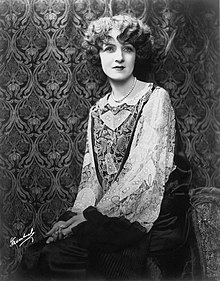|
Claire Windsor
Claire Windsor (born Clara Viola Cronk; April 14, 1892 – October 24, 1972) was an American film actress of the silent screen era. Early lifeWindsor was born Clara Viola Cronk (nicknamed "Ola") in 1892 in Marvin (later known as Glade), Kansas, to parents of Scandinavian descent, George Edwin Cronk and Ella Rose Fearing (later called "Rosella"), who married on October 21, 1885, in Davenport, Iowa. Their first child, a son, died shortly after birth.[1] Her parents later moved to Cawker City, Kansas when she was two years old. At some point, Claire's sister, Nellie, was born. Claire attended Washburn Preparatory Academy in Topeka from 1906 to 1907. After a year at Broadway High School, Seattle, Washington, she returned as a student in the Fine Arts Department at Washburn College. Intent on further refining her daughters' education and position in society, Rosella and her daughters returned to Seattle in the fall of 1910. On July 14, 1913, Claire ("Ola") was chosen for the role of Empress during the lavish musical production of Jappyland. While living in Seattle, Ola met David Willis Bowes and the intense relationship continued by correspondence after Mr. Bowes' return to Denver. Soon a June wedding was planned, but en route back to Kansas, Ola and Bowes wed secretly on May 13, 1914, in Denver, Colorado. The union resulted in the birth of a son, David Willis Bowes Jr., on September 9, 1916, but the couple soon went their separate ways. Bowes officially filed for divorce on September 14, 1920. Ola moved to California to be reunited with her parents who had recently retired. Seeking a way to support herself and baby son, Ola took the advice of a friend and quickly found employment at the movie studios. Initially receiving only bit parts, she was soon spotted by Lois Weber, a highly regarded and influential director and producer of silent films for Paramount Pictures. Weber immediately signed Windsor to a contract.[2] Career climb Claire Windsor's film debut was in the 1920 release of Lois Weber's To Please One Woman which was only a modest success. To promote the nascent starlet, Paramount Pictures often paired Windsor with the newly divorced actor Charlie Chaplin in publicity photographs, leading the tabloid press to give mention to the young actress in print. In 1921, Windsor costarred with Louis Calhern in Weber's The Blot (1921).[2] The publicity paid off; in 1922 the newly formed Western Association of Motion Picture Advertisers (WAMPAS) began their annual WAMPAS Baby Stars awards and she was named, along with Bessie Love, Lila Lee, Mary Philbin and Colleen Moore, as the year's most promising starlets.[3] That same year Claire signed a contract with Goldwyn Pictures Corporation.[2] She would appear in Broken Chains with fellow WAMPAS Baby Star Colleen Moore. In 1923, the former Ola Cronk officially began using the more matinee-friendly Claire Windsor as a moniker. Throughout the 1920s, Windsor established herself as highly regarded leading lady in film. As her career progressed, she was often typecast as the "upscale society girl", often playing the part of a princess, or monied socialite. Critics lauded her elegant fashion sense, and Windsor became a noted trend-setter of 1920s fashion.[3]  In 1924, Windsor was one of the top stars at the newly formed Metro-Goldwyn-Mayer studio. Later, at Tiffany Pictures, Souls for Sables (1925), co-starring Eugene O'Brien, was a box-office hit for Windsor.[2] Personal life and sound filmsWindsor was frequently romantically linked to her leading male co-stars. She reportedly had a well-publicized affair with actor Charles "Buddy" Rogers. In 1925 she married matinée idol Bert Lytell. The couple divorced in 1927. Windsor never remarried, but a few notable love affairs with men caused minor scandals in the press, including once being sued by the young wife of a Boston broker in an "Alienation of Affection" lawsuit, in which the broker's wife contended that Windsor had "stolen her husband".[4] By the late 1920s, Windsor (like so many of her acting peers) found it difficult to move into talkies. She made several talkies throughout the 1930s but could never recapture the success of her earlier years as a silent screen actress. She had a brief stint on a road tour with Al Jolson in the production of The Wonder Bar and occasionally took stage parts. In 1937 she performed at Harold Lloyd's Beverly Hills Little Theatre for Professionals.[5] In her later years, Windsor devoted herself to painting.[4] On April 12, 1943, she legally changed her name to Claire Windsor, and her son took the name of William Willis Windsor.[citation needed] DeathClaire Windsor died of a heart attack on October 24, 1972, at the age of 80 at Good Samaritan Hospital, Los Angeles, California.[6] (Windsor's age at death was reported as 74 in Sidney D. Kirkpatrick's 1986 book Cast of Killers.) She was buried at Glendale's Forest Lawn Memorial Park cemetery.[4] For her contribution to the motion picture industry, Claire Windsor was given a star on the Hollywood Walk of Fame at 7021 Hollywood Blvd. in Hollywood, California on February 8, 1960.[7][8] Filmography
References
Sources
External linksWikimedia Commons has media related to Claire Windsor. |
||||||||||||||||||
Portal di Ensiklopedia Dunia
